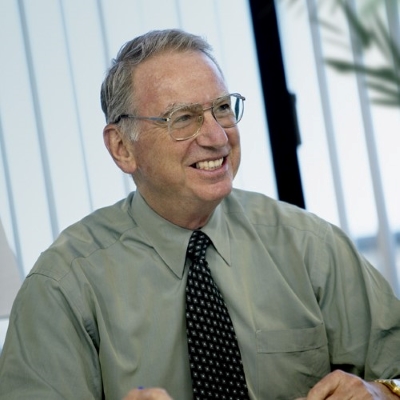Keynote Speaker
| Dr. Irwin M. Jacobs SM '57, ScD '59 Founding Chairman and CEO Emeritus, Qualcomm Inc. |
|---|

Dr. Jacobs received his B.S. in Electrical engineering from Cornell University in 1956 and his S.M. and Sc.D. degrees in Electrical Engineering from MIT in 1957 and 1959. He was a faculty member in Electrical Engineering at MIT from 1959 to 1966, and a Professor of Computer Science and Engineering at UC San Diego from 1966 to 1972. While at MIT, he coauthored Principles of Communication Engineering, the first textbook on digital communications and information theory. In 1968, Jacobs co-founded Linkabit Corporation, progressing from consulting services to become a major supplier of digital communication equipment for government and industry. It was selected by ARPA (now DARPA) to develop SATNET to extend the ARPANET to Europe. In 1977, SATNET was one of three networks used in the first live demonstration of the Internet protocol. Industry-first products developed and manufactured by Linkabit included the dual-modem satellite terminal for the Air Force, based on what was later named reduced instruction set processing (RISC), the VideoCipher encrypted satellite-to-home TV system initially for HBO and later industry-wide, and the very-small-aperature satellite terminal (VSAT) business communication system initially for Schlumberger but then commercialized and adopted by Walmart, 7-Eleven, and many gasoline stations for credit card transactions. He sold Linkabit to M/A-Com in 1980, remaining as board member and executive vice-president until April 1985. With six others from Linkabit, he co-founded Qualcomm July 1, 1985, serving as Chairman and CEO until retiring as CEO in 2005 and Chairman in 2008. Under his leadership, Qualcomm pioneered CDMA technology for the cellular industry, first commercially deployed in Hong Kong in 1995 and in South Korea and the United States in 1996. These second generation (2G) networks initially utilized handsets manufactured in San Diego by Qualcomm. Because CDMA supports efficient voice and mobile wideband internet access, it became the underlying technology for all third-generation (3G) cellular networks, serving billions of subscribers. Qualcomm led the industry in the transition to fourth generation (4G) LTE and now is leading the transition to fifth generation (5G). It licenses its technology worldwide and is among the largest suppliers to global manufacturers of integrated circuits for mobile devices. Jacobs is a member and past chairman of the National Academy of Engineering, a member of the American Academy of Arts and Sciences, the American Philosophical Society, the National Inventors Hall of Fame, and a Fellow of the IEEE, American Association for the Advancement of Science, and the Computer History Museum. From 2006 to 2016, he was Board Chair of the Salk Institute for Biological Studies and for 17 years served on the Advisory Board of the School of Economics and Management at Tsinghua University in Beijing. Jacobs has received many awards and honors, including the National Medal of Technology (1994), the James Clerk Maxwell Award, the IEEE Alexander Graham Bell Medal Award, the Dorothy I. Height Chair’s Award, of the Leadership Council on Civil Rights, the Franklin Institute Bower Award for Business Leadership, the Marconi Prize, the IEEE Medal of Honor, the Carnegie Medal of Philanthropy with his wife Joan, and the IMEC Lifetime of Innovation Award. He is the recipient of 10 honorary doctorates. Dr. Jacobs and his wife Joan are active philanthropists and founding signers of the Giving Pledge. They have provided major support to the UC San Diego Jacobs School of Engineering, the UCSD Jacobs Medical Center, the Jacobs Technion-Cornell Innovation Institute, the San Diego Symphony, the San Diego Central Library, the Jacobs-Cushman Food Bank, the High Tech High Charter School System, and the Jacobs Institute for Innovation in Education at the University of San Diego. They annually support fellowships and scholarships for students at UCSD, Cornell, MIT, the Technion, and three New Bedford High Schools. |